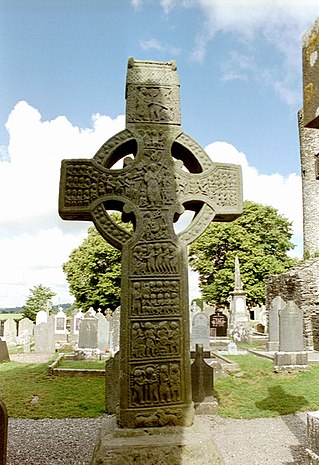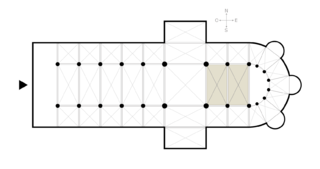

An eagle lectern is a lectern in the shape of an eagle on whose outstretched wings the Bible or other texts rest. [1] They are common in Christian churches and may be in stone, wood or metal, usually brass.


An eagle lectern is a lectern in the shape of an eagle on whose outstretched wings the Bible or other texts rest. [1] They are common in Christian churches and may be in stone, wood or metal, usually brass.
Eagle lecterns in stone were a well-established feature of large Romanesque pulpits in Italy. The carved marble eagle on the Pulpit in the Pisa Baptistery by Nicola Pisano (1260) is a famous example, and they also feature on his Siena Cathedral Pulpit (1268), and his son's at Sant' Andrea, Pistoia (Giovanni Pisano, 1301). These are projections from the stone ledge or the pulpit, but wood and brass examples usually top a stand that brings them to the appropriate height.
Medieval examples survive in a number of English churches, including the church of St Margaret in Kings Lynn and the parish church in Ottery St Mary; they appear to have been often regarded as harmless by the iconoclasts of the English Reformation and English Commonwealth, surviving when most church art was destroyed.

In the later Middle Ages, they became a common showpiece for the developing brassworking industry, initially mainly in the Low Countries and in Mosan art, but then spreading elsewhere. The brass Dunkeld Lectern is another notable medieval eagle lectern, made in Scotland, but taken as a trophy to and fro between Scotland and England. Medieval lecterns sometimes depict the eagle grasping a snake in its beak, and sometimes the bird has two heads. [2]
There are several theories regarding the symbolism of the eagle lectern. It is sometimes said to have derived from the belief that the bird was capable of staring into the sun and that Christians similarly were able to gaze unflinchingly at the revelation of the divine word. [1] Alternatively, the eagle was believed to be the bird that flew highest in the sky and was therefore closest to heaven, and symbolised the carrying of the word of God to the four corners of the world. [3] The eagle is also the symbol of John the Apostle, and for this reason may have come to represent the inspiration of the gospels as a whole. [4] Another theory holds that the eagle represents Christ. [2]

A cadaver monument or transi is a type of funerary monument to a deceased person, featuring a sculpted tomb effigy of a skeleton, or of an emaciated or decomposing dead body, with closed eyes. It was particularly characteristic of the Late Middle Ages when they were designed to remind viewers of the transience and vanity of mortal life, and the eternity and desirability of the Christian after-life. The format is in stark contrast to gisants, which are always recumbent, in full dress, with open eyes and hands clasped and raised in prayer.

A high cross or standing cross is a free-standing Christian cross made of stone and often richly decorated. There was a unique Early Medieval tradition in Ireland and Britain of raising large sculpted stone crosses, usually outdoors. These probably developed from earlier traditions using wood, perhaps with metalwork attachments, and earlier pagan Celtic memorial stones; the Pictish stones of Scotland may also have influenced the form. The earliest surviving examples seem to come from the territory of the Anglo-Saxon kingdom of Northumbria, which had been converted to Christianity by Irish missionaries; it remains unclear whether the form first developed in Ireland or Britain.

Cathedrals, collegiate churches, and monastic churches like those of abbeys and priories, often have certain complex structural forms that are found less often in parish churches. They also tend to display a higher level of contemporary architectural style and the work of accomplished craftsmen, and occupy a status both ecclesiastical and social that an ordinary parish church rarely has. Such churches are generally among the finest buildings locally and a source of regional pride. Many are among the world's most renowned works of architecture. These include St Peter's Basilica, Notre-Dame de Paris, Cologne Cathedral, Salisbury Cathedral, Antwerp Cathedral, Prague Cathedral, Lincoln Cathedral, the Basilica of Saint-Denis, Santa Maria Maggiore, the Basilica of San Vitale, St Mark's Basilica, Westminster Abbey, Saint Basil's Cathedral, Antoni Gaudí's incomplete Sagrada Família and the ancient cathedral of Hagia Sophia in Istanbul, now a mosque.

An altarpiece is an work of art in painting, sculpture or relief representing a religious subject made for placing at the back of or behind the altar of a Christian church. Though most commonly used for a single work of art such as a painting or sculpture, or a set of them, the word can also be used of the whole ensemble behind an altar, otherwise known as a reredos, including what is often an elaborate frame for the central image or images. Altarpieces were one of the most important products of Christian art especially from the late Middle Ages to the era of Baroque painting.

Medieval architecture was the art of designing and constructing buildings in the Middle Ages. Major styles of the period include pre-Romanesque, Romanesque, and Gothic. The Renaissance marked the end of the medieval period, when architects began to favour classical forms. While most surviving medieval constructions are churches and military fortifications, examples of civic and domestic architecture can be found throughout Europe, including in manor houses, town halls, almshouses, bridges, and residential houses.

A pulpit is a raised stand for preachers in a Christian church. The origin of the word is the Latin pulpitum. The traditional pulpit is raised well above the surrounding floor for audibility and visibility, accessed by steps, with sides coming to about waist height. From the late medieval period onwards, pulpits have often had a canopy known as the sounding board, tester or abat-voix above and sometimes also behind the speaker, normally in wood. Though sometimes highly decorated, this is not purely decorative, but can have a useful acoustic effect in projecting the preacher's voice to the congregation below, especially prior to the invention of modern audio equipment. Most pulpits have one or more book-stands for the preacher to rest his bible, notes or texts upon.

A tetramorph is a symbolic arrangement of four differing elements, or the combination of four disparate elements in one unit. The term is derived from the Greek tetra, meaning four, and morph, shape.

A minbar is a pulpit in a mosque where the imam stands to deliver sermons. It is also used in other similar contexts, such as in a Hussainiya where the speaker sits and lectures the congregation.

The rood screen is a common feature in late medieval church architecture. It is typically an ornate partition between the chancel and nave, of more or less open tracery constructed of wood, stone, or wrought iron. The rood screen would originally have been surmounted by a rood loft carrying the Great Rood, a sculptural representation of the Crucifixion. In English, Scottish, and Welsh cathedrals, monastic, and collegiate churches, there were commonly two transverse screens, with a rood screen or rood beam located one bay west of the pulpitum screen, but this double arrangement nowhere survives complete, and accordingly the preserved pulpitum in such churches is sometimes referred to as a rood screen. At Wells Cathedral the medieval arrangement was restored in the 20th century, with the medieval strainer arch supporting a rood, placed in front of the pulpitum and organ.

A Pictish stone is a type of monumental stele, generally carved or incised with symbols or designs. A few have ogham inscriptions. Located in Scotland, mostly north of the Clyde-Forth line and on the Eastern side of the country, these stones are the most visible remaining evidence of the Picts and are thought to date from the 6th to 9th century, a period during which the Picts became Christianized. The earlier stones have no parallels from the rest of the British Isles, but the later forms are variations within a wider Insular tradition of monumental stones such as high crosses. About 350 objects classified as Pictish stones have survived, the earlier examples of which holding by far the greatest number of surviving examples of the mysterious symbols, which have long intrigued scholars.

A khachkar or Armenian cross-stone is a carved, memorial stele bearing a cross, and often with additional motifs such as rosettes, interlaces, and botanical motifs. Khachkars are characteristic of medieval Christian Armenian art.

A misericord is a small wooden structure formed on the underside of a folding seat in a church which, when the seat is folded up, is intended to act as a shelf to support a person in a partially standing position during long periods of prayer.

A lectern is a reading desk with a slanted top, on which documents or books are placed as support for reading aloud, as in a scripture reading, lecture, or sermon. A lectern is usually attached to a stand or affixed to some other form of support. To facilitate eye contact and improve posture when facing an audience, lecterns may have adjustable height and slant. People reading from a lectern, called lectors, generally do so while standing.

A monumental brass is a type of engraved sepulchral memorial once found through Western Europe, which in the 13th century began to partially take the place of three-dimensional monuments and effigies carved in stone or wood. Made of hard latten or sheet brass, let into the pavement, and thus forming no obstruction in the space required for the services of the church, they speedily came into general use, and continued to be a favourite style of sepulchral memorial for three centuries.

Romanesque art is the art of Europe from approximately 1000 AD to the rise of the Gothic style in the 12th century, or later depending on region. The preceding period is known as the Pre-Romanesque period. The term was invented by 19th-century art historians, especially for Romanesque architecture, which retained many basic features of Roman architectural style – most notably round-headed arches, but also barrel vaults, apses, and acanthus-leaf decoration – but had also developed many very different characteristics. In Southern France, Spain, and Italy there was an architectural continuity with the Late Antique, but the Romanesque style was the first style to spread across the whole of Catholic Europe, from Sicily to Scandinavia. Romanesque art was also greatly influenced by Byzantine art, especially in painting, and by the anti-classical energy of the decoration of the Insular art of the British Isles. From these elements was forged a highly innovative and coherent style.

A choir, also sometimes called quire, is the area of a church or cathedral that provides seating for the clergy and church choir. It is in the western part of the chancel, between the nave and the sanctuary, which houses the altar and Church tabernacle. In larger medieval churches it contained choir-stalls, seating aligned with the side of the church, so at right-angles to the seating for the congregation in the nave. Smaller medieval churches may not have a choir in the architectural sense at all, and they are often lacking in churches built by all denominations after the Protestant Reformation, though the Gothic Revival revived them as a distinct feature.

An antependium, also known as a pulpit fall, parament or hanging, or, when speaking specifically of the hanging for the altar, an altar frontal, is a decorative piece, usually of textile, but also metalwork, stone or other material, that can adorn a Christian altar.

The term Poor Man's Bible has come into use in modern times to describe works of art within churches and cathedrals which either individually or collectively have been created to illustrate the teachings of the Bible for a largely illiterate population. These artworks may take the form of carvings, paintings, mosaics or stained-glass windows. In some churches a single artwork, such as a stained-glass window, has the role of Poor Man's Bible, while in others, the entire church is decorated with a complex biblical narrative that unites in a single scheme.

Art in bronze and brass dates from remote antiquity. These important metals are alloys, bronze composed of copper and tin and brass of copper and zinc.

The pulpit in the Pisa Baptistery was completed by Nicola Pisano and his assistants in 1260, and has long been regarded as a landmark in Italian art, especially for its large relief panels around the platform. For Kenneth Clark the pulpit was "that false dawn of the Renaissance", as its innovations were not followed up for some time. The nude male figure, called Daniel or Fortitude, but based on a Roman Hercules, has long been a particular focus of attention as "the first heroic nude in Italian art".